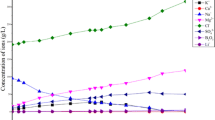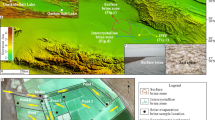Abstract
It is well known that there are two patterns of potash deposition in lacustrine facies: “tear drop pattern” (the Dabsan saline lake is a typical example) and “bull's eye pattern”. Potash-forming in tear drop pattern is still continuing.
The 2,678 m A. S. L. lake in the middle of the Qarhan playa in the Qaidam Basin covers an area of 210 km2, and has an average depth of 0.39 m. Its MgCl2 type surface brine is 280–340 g/l in salinity and mainly consists of Na, K, Mg and Cl. As a rule, the potash deposits occur as evaporite distributed in tear drop pattern at the northern and northeastern lakeshore zones. They mostly consist of carnallite and halite, occasionally sylvite. The deposition is very unstable and controlled principally by the varying supply of deposit materials from the Golmud River in the south.
The potash deposits were formed when concentration of the surface brine reached a certain degree in the main evaporating season. Their forming process followed some crystalization paths in the phase diagram for the Na, K, Mg/Cl H2O equilibrium system.
Such a sedimentary model of potash deposits in the lacustrine facies is relatively common in nature. Under the extremely arid climate, differential concentration of the nonhomogeneous potassium-rich surface brine produced the potash deposits. Qarhan Salt Lake also had the same pattern of potash depositions and so, in a sense, the Dabsan saline lake is the continuation of the Qarhan salt lake in terms of potash formation.
Schmalz (1970) put forward two distributive patterns for evaporite: “tear drop pattern” and “bull's eye pattern”. These patterns exist in both marine and continental salt-bearing basins (including recent salt lakes), and are controlled by the conditions of physical geography, hydrogeology, sedimentology and climatology of each basin. In his works (Sun, 1981; 1984; 1986; 1988) on the origins of potash deposits, the author always referred to them as two models of potash formation.
The “tear drop pattern” is one of the salt-forming models and also an important potash-forming model. This paper deals with the formative mechanism of the tear drop pattern potash deposition by presenting the Dabsan saline lake as an example and elucidates on the distributive characteristics and formative processes of potash deposits in the lake.
Similar content being viewed by others
References
Schmalz, R. F., 1970. Environment of marine evaporate deposition,Miner. Ind.,35 (8): 1–7.
Sun Dapeng, 1981. On origins of potash deposits in continental potash-bearing basins.Kexue Tongbao 26: 815–820.
Sun Dapeng, 1984. Distribution and formation of salts and their relationship with petroleum generation in Qaidam Basin,Oil and Gas Geology 5(2): 132–139 (In Chinese, with English Abstract).
Sun Dapeng, 1986. The origins of potash deposits in continental potash-bearing basins.Minerals and rocks.6 (2): 34–45 (In Chinese, with English Abstract).
Sun Dapeng, 1988. Origin of potash deposits in Qaidam Basin,“Scientia Sinica” Series B 11: 1323–1333 (In Chinese).
Sun Dapeng, 1974. The origin of recent potash deposits in a certain salt lake, China.Geochemistry,4: 230–248 (In Chinese, with English Abstract).
Sun Dapeng, 1988. The formation, evolution and potash-forming action of Qarhan Salt Lake, Proceedings of the Third Chinese Oceanological and Limnological Science Conference, Science Press, pp. 186–200 (In Chinese, with English Abstract).
Valyashko, M. G., 1962. Geochemical Regularity for the Formation of Potash Ore Deposits, Moscow University Press, pp. 311–312 (In Russian).
Author information
Authors and Affiliations
Rights and permissions
About this article
Cite this article
Dapeng, S. “Tear drop pattern” potash deposits in lacustrine facies. Chin. J. Ocean. Limnol. 8, 50–65 (1990). https://doi.org/10.1007/BF02846452
Received:
Issue Date:
DOI: https://doi.org/10.1007/BF02846452




